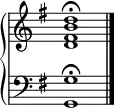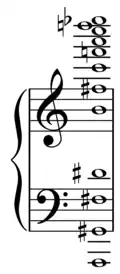Major seventh chord
In music, a major seventh chord is a seventh chord in which the third is a major third above the root and the seventh is a major seventh above the root. The major seventh chord, sometimes also called a Delta chord, can be written as maj7, M7, Δ, ⑦, etc. The "7" does not have to be superscripted, but if it is, then any alterations, added tones, or omissions are usually also superscripted. For example, the major seventh chord built on C, commonly written as Cmaj7, has pitches C–E–G–B:
| Component intervals from root | |
|---|---|
| major seventh | |
| perfect fifth | |
| major third | |
| root | |
| Tuning | |
| 8:10:12:15[1] | |
| Forte no. / | |
| 4–20 / |

It can be represented by the integer notation {0, 4, 7, 11}.
According to Forte, the major seventh chord is exemplified by IV7, which originates melodically.[3]
The just major seventh chord is tuned in the ratios 8:10:12:15, as a just major chord is tuned 4:5:6 and a just major seventh is tuned 15:8.
The minor flat sixth chord (minor triad with an added minor sixth) is an inversion of this chord.
Examples
In 1888, the French composer Erik Satie composed three slow waltzes, entitled Gymnopédies. The first and best-known of these alternates two major seventh chords. The first eight measures (shown below) alternate between Gmaj7 and Dmaj7.
Later examples of tonic major seventh chords include Henry Mancini's Theme from Charlie's Angels, Joseph Kosma's "Autumn Leaves",[4] The Beatles' "This Boy",[5] Eagles' "One of These Nights", Bread's "Make It With You", America's "Tin Man", Blood Sweat & Tears' "You've Made Me So Very Happy", the third (main) part of Paul McCartney and Wings' "Band On The Run", Carly Simon's "The Right Thing to Do", and Chicago's "Colour My World".[6]
Common in jazz since the Jazz Age of the 1920s, major seventh chords appeared frequently in compositions of genres influenced by jazz in the subsequent decades, such as traditional pop, bossa nova, and easy listening. Moving into the 1970s to replace the prominence of the dominant seventh chord as a stable tonic more common in the first fifteen years of the rock era, the major seventh was common in all styles, "pervading soul, country rock, soft rock, MOR (middle-of-the-road styles), jazz rock, funk, and disco."[6] Music theorist Ken Stephenson continues:
In soul and disco, a tonic minor seventh harmony often alternated with a dominant seventh or dominant ninth chord on
['Lady Marmalade' & 'Le Freak']... In other styles, major seventh and minor seventh chords generally mix (usually with eleventh chords...) to create a diatonic composite in either major or minor mode.... The most famous major seventh chord in the history of music, [is] the one that opens... 'Colour My World', even though the song departs from the usual pattern described above by 'colouring' the harmonic succession with several chromatic chords. Still, seven of that song's fourteen chords, including the tonic, are major sevenths or ninths, demonstrating the primacy of that chord type.[6]
Pieces which feature prominent major seventh chords include: Tadd Dameron's "Lady Bird",[7] and "This Guy's in Love with You", [8] by Burt Bacharach and Hal David.
Major seventh chord table
Chord Root Major third Perfect fifth Major seventh Cmaj7 C E G B C♯maj7 C♯ E♯ (F) G♯ B♯ (C) D♭maj7 D♭ F A♭ C Dmaj7 D F♯ A C♯ D♯maj7 D♯ F  (G)
(G)A♯ C  (D)
(D)E♭maj7 E♭ G B♭ D Emaj7 E G♯ B D♯ Fmaj7 F A C E F♯maj7 F♯ A♯ C♯ E♯ (F) G♭maj7 G♭ B♭ D♭ F Gmaj7 G B D F♯ G♯maj7 G♯ B♯ (C) D♯ F  (G)
(G)A♭maj7 A♭ C E♭ G Amaj7 A C♯ E G♯ A♯maj7 A♯ C  (D)
(D)E♯ (F) G  (A)
(A)B♭maj7 B♭ D F A Bmaj7 B D♯ F♯ A♯
Major seventh chords for guitar
In standard tuning, the left is the low E string. To the right of the | is another way of playing the same chord. x means mute the string. (The Amaj7 demonstrates the movable chord shapes.)
- Amaj7: xx7654 | xxx224 | xx7999 | x02120 | 576655
- Bmaj7: x24342 | 7988xx
- Cmaj7: x35453 | x32000 | x35453[9]
- Dmaj7: xx0222 | x57675
- Emaj7: xx2444 | 021100
- Fmaj7: xx3555 | 103210 | xx3210
- Gmaj7: xx5777 | 320002
See also
References
- Shirlaw, Matthew (1900). The Theory of Harmony, p. 86. ISBN 978-1-4510-1534-8.
- Walter Everett (Autumn, 2004). "A Royal Scam: The Abstruse and Ironic Bop-Rock Harmony of Steely Dan", p. 205, Music Theory Spectrum, vol. 26, no. 2, pp. 201–235.
- Forte, Allen (1979). Tonal Harmony in Concept & Practice, p. 150. ISBN 0-03-020756-8.
- Kosma, J. and Mercer, J. (1947) "Autumn Leaves." Enoch & Company.
- MacDonald, I. (2005, p. 103) Revolution in the Head: The Beatles' Records and the Sixties. London, Pimlico.
- Stephenson, Ken (2002). What to Listen for in Rock: A Stylistic Analysis, p. 83. ISBN 978-0-300-09239-4. "...the most famous major seventh chord in the history of music, the one that opens Chicago's 'Colour My World'..."
- Radley, Roberta (2011). The "Real Easy" Ear Training Book, pages unmarked. ISBN 9781457101427
- Bacharach B. and David, H. (1989, p144) Burt Bacharach Anthology, New York, Warner Brothers
- "Cmaj7, Cmaj7 Chords on Guitar". guitartwitt. 2023-03-26. Retrieved 2023-04-04.



